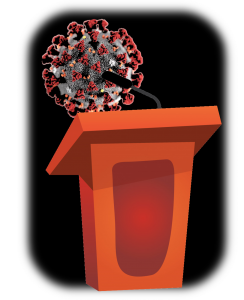COVID-19 Has a Publicity Problem
 Poor, maligned COVID. It keeps us from seeing our families, forces us to wear uncomfortable masks, and kills thousands of people. On top of that we have local governments telling us what we can’t do and politicians telling us that we’re going to kill our grandparents. Poor COVID. It really needs a better PR representative.
Poor, maligned COVID. It keeps us from seeing our families, forces us to wear uncomfortable masks, and kills thousands of people. On top of that we have local governments telling us what we can’t do and politicians telling us that we’re going to kill our grandparents. Poor COVID. It really needs a better PR representative.
Have you noticed that if you allow a toddler to sweep the floor, they are happy to participate, but if you tell them that they can’t have a snack unless they sweep the floor you’re in for a tantrum? We all have a little toddler in us, and it’s good to remember that when making public policy.
To be clear, I’m firmly in the camp that we must mitigate this spread. My family bubble consists of only my household and one set of grandparents. Everyone – and I mean everyone – else gets the mask, social distance, and/or outside treatment. I’m not here to discuss why the restrictions are ruining our civil liberties, and how my rights are more important than your grandmother’s life. If that’s where you think this was going, you will be sorely disappointed.
Our public policy (at least at the local level) is generally well intentioned, emphasizing measures that will mitigate spread of the virus. This is important both as a public health measure and a way to keep our economy humming. But the toddlers in us rebel against being told what we can’t do, especially when the basis is poorly understood.
Lately, much has been written about the lack of transparency in formulating public policy. Coupled with the inconsistent messaging in different areas, it seems like they’re just making it up on the fly. Nobody likes being told they can’t do something because, “I told you so” – especially toddlers.
We need to find ways to quell the obstinance of our inner toddler and engage the rationale of our inner adult. Let’s start by telling people what they can do and support that with transparent bases for why mitigations work. There will still be some people that let their toddler instinct rule, but we stand a better chance when we give our inner adult the bargaining ammunition they need.
We can do a surprising amount of things while mitigating spread of the virus. With the proper controls in place we can meet socially, work in our office, send our kids to school, go to concerts, and most things that we did before the pandemic. That seems WAY different than what we’re hearing from local officials. “I thought you were a hard core advocate of mitigating spread? What happened to lock downs?”
The key part of that paragraph is “the proper controls”. To be able to safely do all of these things, we need easy to implement controls that have a clear and understandable basis. The poster children are well known: hand washing, mask wearing, and social distancing. These types of controls target spread through surface contamination, either by limiting the amount of contamination (mask wearing) or the pathways for ingestion (hand washing and social distancing). If this was all we were asked to do and still permitted to go about business as usual, there would likely be little resistance given the proper messaging. But there’s clearly more to this story.
A less universally understood way of spreading virus is through aerosol transmission. I cover this extensively in an SES newsletter which goes into the technical nuts and bolts, but the distillation is that people exhale microscopic particles that hang around, just waiting to be inhaled by others sharing the same air. Essentially we’re swapping spit with everyone we’re sharing air with. The current mitigations are that people just can’t be in the same space with each other. “NO” screams our inner toddler when told that we should close our businesses and only meet outside. “NO, NO, NOOO!” It’s an understandable reaction based on a sense of “I told you so” basis and a lack of available information.
A better approach would be to actually address the cause of spread and focus our efforts on mitigation. That includes ensuring adequate fresh air exchange, plenty of air mixing internally, limiting our contact time, and of course wearing masks to limit the particles in the air in the first place. The problem with this approach is that we have to admit that aerosol spread is real, and provide people with tools so they can understand what mitigations have the most impact and why. Let the adult reason with the toddler instead of dictate.
“But that seems really complicated. How can we possibly understand something we don’t see?” This sentiment is exactly what led us down the road of no indoor gatherings and the predictable backlash. We understand dangers we can’t see like Radon all the time, so that may not be a large hurdle. The more important part is how mitigations impact this invisible threat. That is far easier than one would think. In a bored afternoon I was able to put together a simple model that provides insight on how risky an indoor gathering is relative to say, a maskless meeting with someone infected for fifteen minutes (the generally accepted standard for contact tracing). If you’re curious, you can submit a scenario online here and try it yourself.
Imagine if every indoor space could provide you some information on your relative risk of catching COVID-19 (based on your residence time) before you entered. Would you feel safer? Would you be less hesitant to send your kids back to school if you knew that they put documented controls in place that decrease aerosol transmission? And what if the basis for the assessment was a readily viewable document that told you the inputs to the determination and the basis for its results? We read cereal box labels. This would be no different.
In the end, COVID-19 is getting a bad rap. It’s not some insidious force trying to kill us, it’s a virus with easily controllable transmission pathways. We need to stop blaming poor SARS-CoV-2 for all the things we can’t do, and instead focus on what it can’t keep us from doing. COVID needs a new PR representative.
-Demetrius Siachames
